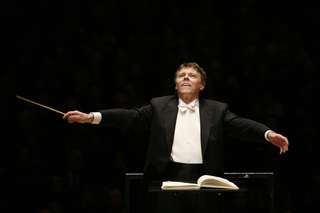|
Back
Heavenly Length, Immortal Ideas New York
Isaac Stern Auditorium, Carnegie Hall
02/17/2010 -
Gustav Mahler: Symphony No. 3 in D Minor
Jill Grove (Mezzo-soprano)
New York Choral Artists, Joseph Flummerfelt (Chorus Director), The American Boyschoir (Fernando Malvar-Ruiz (Music Director), Royal Concertgebouw Orchestra, Mariss Jansons (Chief Conductor)

M. Jansons (© Jennifer Taylor)
More than any Mahler symphony, the Third illustrates the composer’s thesis that “Composing a symphony is composing a world.” Yes, this 1 hour and 40 minute piece is of “heavenly length” (to plagiarize Schumann about Schubert). And when played with such heavenly passion by Mariss Jansons and the Royal Concertgebouw Orchestra (RCO), every minute, every second, shares in this heavenly quality.
But Mahler was only partly interested in portraying heaven. His descriptions today may sound mawkish–”Pan’s Awakening”, “What the animals in the forest tell me”, “What the angels tell me”–but the emotions he awakens in us run the human gamut, from death, madness, chaos, frivolity and demons to bliss, reverence and, yes, the adoration of sheer beauty.
After opening night, one wouldn’t have imagined the RCO capable of doing this. Their Sibelius and Rachmaninoff were constrained, pretty and poetic. Last night, that changed after the opening five-measure horn call, with the sharpest downward thrust I have ever heard in this symphony. As if Maestro Jansons had substituted a samurai sword for his baton, he cut through the orchestra and never stopped his swordsmanship for all 40 minutes.
Nothing was mellow about the RCO. Those eight horns resounded through Isaac Stern Auditorium like whiplashes (as they did until a couple of well-earned fluffs in the finale), the quartets of trumpets and trombones, both solo and full consorts were calls to battle or to the flames. And in this movement, those woodwinds–which were used to snicker, sicken, play awkward, sometimes grotesque measures–did their part all too well.
For Mr. Jansons never hesitated in bringing out the most macabre feeling of the development. A movie of the movement might be titled “Two Funerals and a Hellhole” The development was plainly satanic. One thought first of early Shostakovich, but that was too human. This was Satanic music, albeit with the abrupt momentary changes. Mr. Jansons tore out every separate contrapuntal line, then stitched them back together. The movement still is unequaled–and undescribable–in any symphonic literature, and the RCO had the instrunental power to make it seethe with the right fury.
Mahler knew the effects he wanted, of course, and he asked for a few minutes of silence before the ersatz “minuet”. (Recordings never pay attention: Mr. Jansons certainly did.) That movement was a short respite of sanity, and here it sounded like a chamber orchestra!
For the Scherzando, everyone waits to see the posthorn. Alas, they were disappointed, since Mr. Jansons placed the soloist offstage. That was visually disappointing, but musically correct for most of it. The final quintet, with four horns, didn’t quite have the right effect, but the effort was authentic.
One reason for the rarity of the Third is economic. You must have a good mezzo (for a single movement), an excellent children’s chorus (which sings two words: “Bimm, Bamm”) and a more than competent women’s chorus for about ten minutes of singing. Mr. Jansons partly succeeded.
I was not impressed with that excellent Wagnerian Jill Grove. She was placed to the side of the orchestra, and while her voice was clear and emotional, the heavy vibrato seemed more operatic than religio-symphonic.
No hesitation, though, for the American Boyschoir, who always turn up trumps with enthusiasm, clarity and perfect melodic strength (even when they are confined to tintinnabulation). The women of the New York Choral Artists blended in well with their young descant singers.
Whatever wonders the RCO produced, to these ears the most beautiful moment had no sound at all. With the final pianissimo bell sound, Mahler exhorts the conductor to follow directly with the prayerful music. Mr. Jansons didn’t quite follow directions. With the Boyschoir dying out, the conductor waited perhaps half a second before the string chorale. That moment by itself was (oh, I hate this next mawkish phase, but can’t resist)… was like the space between Man and God in the Sistine Chapel’s “Creation”. Between the finite Mind of Humankind and the infinite Spirit of What Lies Beyond.
Gustav Mahler, through his life, never hesitated in trying to deal with both. In some symphonies (the First and The Song of the Earth), he saw nature. In the choral works, he tried to see God. In the Third, he tried to see Hell, Heaven and our Middle Kingdom and all that it implied.
The Royal Concertgebouw Orchestra, through its history, has projected the essence of Mahler. Mr. Jansons, has communicated the inspiration. And to the best of our poor mortal efforts, he has offered us a benison and a vision.
Harry Rolnick
|